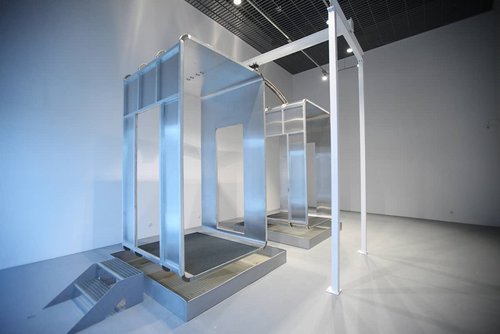Artist Jenny Brockmann is working on the sub-project (Un-)equilibrium - organ - BALANCE. She investigates communication processes with the world surrounding us—with living and non-living modes of existence—through artistic research. The sub-project envisages a distributed experiment which tests a collectively-balanced critical equilibrium via felt communication and embodied knowledge, thus opening a space for the formation of a new subjectivity.
This sub-project uses advanced computer technology to put the non-human, human, natural, and the artificial into communication to such an extent that the usual relations of object and subject are (temporarily) reversed. Inspired by the Internet of Things (Ashton 2009), the following research questions are central: How does animism influence the established (un-)equilibria between the object and the subject? Can sensations of equilibrium take place across Western and non-Western localities? Is it possible to establish a “collective cyborg” through a data-informed (un)balanced prosthesis that enables new, collective normative processes in posthumanism?
To answer these questions Brockmann will construct a data-dependent physical system that addresses its users through their sense of space or (im)balance, at the same time enabling them to devise new norms for their lives via collective discourse. Brockmann previously realized machinic arrangements in projects such as the (im)balance sculpture Seat#16 (2019) for collective discourse as well as Nature of Knowledge – The Uncertain Structure (2019), a data-based realtime experiment in two different locations.
The concept of the new project is to distribute the principle of the installation Seat#16 using the Internet to several locations in Western and non-Western regions of the Global North and Global South. The basic idea of Seat#16 is the physical connection between individuals, where each one feels the other through movements and vibrations. This creates a situation of equilibrium in which each person must pay attention to the other, is stabilized by the other, but is also “unsettled,” creating an overall “felt” communication. In the planned machinic arrangement, this situation will be technically/spatially transformed, geographically distributed, and then reconnected via the Internet. This new machine will allow people in different locations around the world to “feel” each other and be connected in an equilibrium-based system.
This distributed experiment shifts the research process of the project Animism/Maschinism: Configurations of Critique between Science, Art, and Technology and the data, images, texts and materials generated by it into the art space in order to reconfigure and experimentally test them there—in constant exchange with the participating scientists, external experts from other disciplines, a local audience, and the international digital public. The focus will be on the dialogue between science and art, but medicine, religion, and law will also be included. The resulting interactive spaces will be explored in more detail in terms of artistic research. The observations of all participants on their sense of (im-)balance will be understood as “embodied knowledge,” i.e. as sensual, physical, and felt knowledge.
The project focuses on the notion of diversity, the technical extension of humans in robotics and AI, and here in particular the question posed by Donna Haraway of how normative processes can be rethought in the creation of “new beings” and “new environments” through technological innovation. In this context, it will also be examined if, and how, the much-cited “sentience of technology” can be influenced in such a way that a new beginning becomes possible in which a critically-balanced communication between the same and simultaneously the diverse (Hannah Arendt) can be generated.

